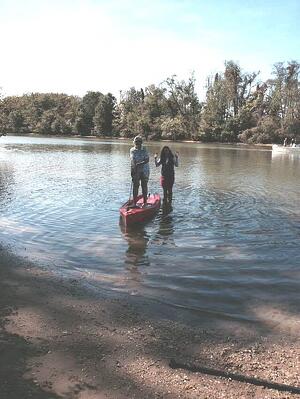The biggest threat for occupancy in senior living appears to be the family home. And as technology advances, it gets easier for older adults to remain in the comfort of their familiar surroundings. After all, it is an enormous undertaking to move from your long time family home to a new place. The physical burden of the move (and downsizing) coupled with a strong and heavy psychological undercurrent to acknowledging that this will be your last move makes it extremely challenging.
Until there is a strong enough push (or pull) for older adults to leave their home, marketing and sales staff are left in a difficult battle with inertia, because the truth is, most of us don't make changes (in any area of life) unless the pain of staying the same is greater than the pain of making the change. So you have two choices, you can wait for the push of a health crisis that forces older adults to leave their homes, or you can activate a pull message that shows the community as a place where active, engaged living is very much the norm.
[Read More: Using Wellness To Combat Someday Syndrome]
Your wellness program (life enrichment program, activities program...) is the tangible representation of how life is lived in your community and it is the best way to show prospects all the ways they can connect with opportunities FAR beyond what they could cultivate for themselves at home. Here are three opportunities to make the most of your community lifestyle in a pull message with prospective residents.
#1: Fix your fitness center.
Fitness, your fitness center, exercise classes, etc. are only one component of your overall lifestyle program. But, this aspect of living at your community is arguably one of the most visible and recognizable elements (maybe a close second behind dining). If your program consists of a gym with some equipment, classes on the calendar, and possibly fee-based personal training, then you're no different than the gym the prospect already belongs to. Nor are you likely much different from your nearest senior living competition. There is no pull in your services to stimulate the idea of change for a future resident.
Here are some blogs to help you rethink your exercise offerings:
- What's missing from your resident fitness program and how to fix it
- Making the most of your community fitness center
- Community fitness centers - is bigger always better?
#2: Change your calendar.
There's a good chance your calendar looks old and it's just as likely that your enrichment team is  blissfully unaware that there's room for growth in what and how they plan. If you're in a community leadership role, it may have been a while since you took a close look at the activities and events that are planned for your residents. So, maybe you're not sure if your calendar needs more life. The simple exercise below will shed some light on whether your programming represents an area of opportunity.
blissfully unaware that there's room for growth in what and how they plan. If you're in a community leadership role, it may have been a while since you took a close look at the activities and events that are planned for your residents. So, maybe you're not sure if your calendar needs more life. The simple exercise below will shed some light on whether your programming represents an area of opportunity.
- Print the last 3 months of calendars.
- Cross off all events that are repeats within the month: exercise classes, card games, happy hour, book club, birthday lunches, weekly shopping trips, worship services, etc.
- If you don't see at least five to six unique events per month (and that's shooting low), then it's time to rethink how programs and events are planned in the community.
Check out this blog for a fresh perspective on putting purposeful living at the center of life enrichment programming.
[Read More: Top 5 reasons your residents don't engage in wellness]
#3: Adjust your thinking about resident engagement.
I'm intrigued by the Holleran Consulting model for the four domains of resident engagement. (Grab the whitepaper here). My early thoughts were all around how much the domains are the responsibility of a community's life enrichment director. However, the more I digested the content, the more I realized how deep the idea of resident engagement really runs.
There are lots of ways to improve traditional activities in communities, and many of those opportunities rest squarely with your life enrichment staff doing their jobs differently. Yet, beyond the prominent role your activities department plays in facilitating opportunities for resident engagement, it is the entire community supporting those opportunities, connecting with residents, and communicating with each that is the foundation for engagement. Residents also have to be present at a fundamental level. We should not be simply filling an activities calendar and calling it done. For strong engagement, we have to invite residents into their own life story and then step back to allow them to live it.
How you build those pathways for residents to choose the ways they want to engage is the story you sell to prospects when they ask what it's like to live in your community. And, it takes more than your fitness manager and/or your life enrichment director to pull this off. It requires a strategic approach to building a community full of life and then creating a thoughtful approach to sharing that living experience with those who aren't even aware of what they're missing while they reside in their own home.
Simply put: You court a more vibrant consumer when you offer a message that speaks to the ways they engage with life. Stop selling health care and start focusing on how residents can live well in your community.

